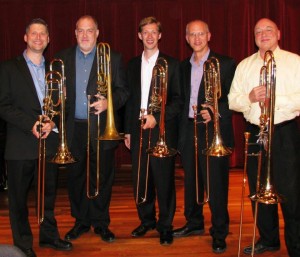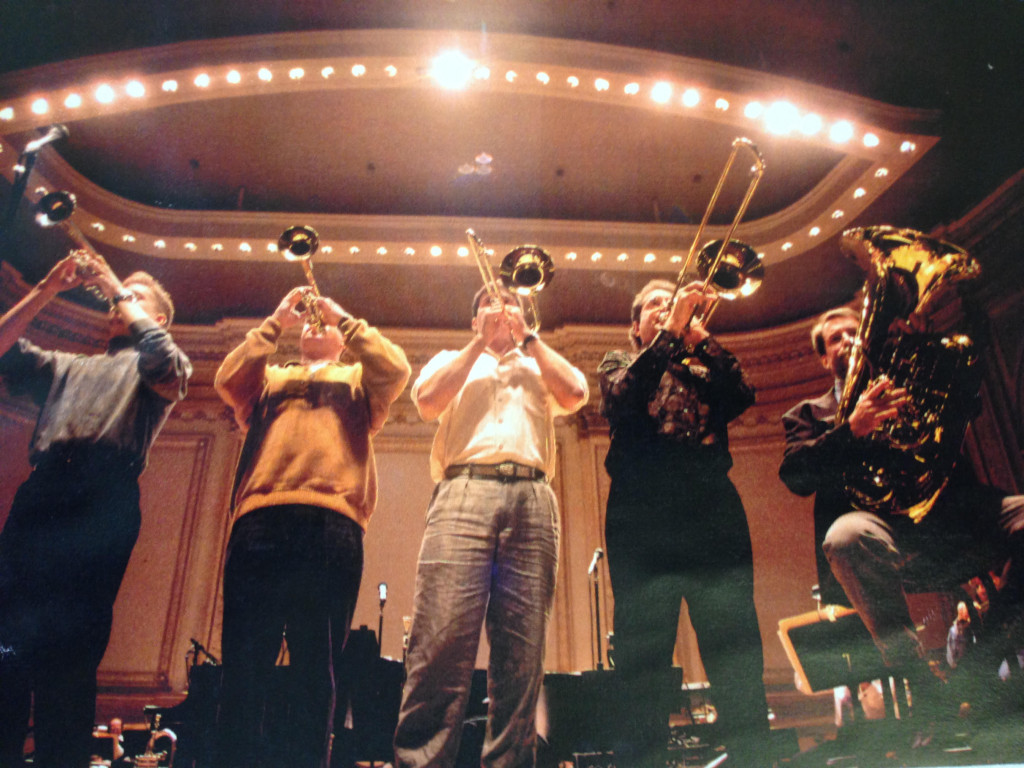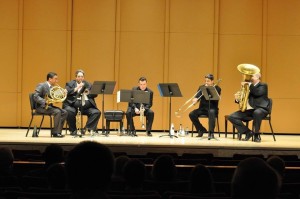 From the ground floor of The Dallas Brass, to the pits of opera orchestras, Dan Satterwhite has been a triple threat: bass trombone, tuba and euphonium-later cimbasso. While his first love was euphonium, early experiences hearing Charlie Vernon convinced him to take up the bass trombone as his fist instrument. As he explored chamber music, tuba became an important step in Mr. Satterwhite’s musical development. From off broadway productions to orchestras, Satterwhite is now equally at home with four valves as he is with “Seven Positions” tm. Read on to discover how to hold down all the low brass chairs…..
From the ground floor of The Dallas Brass, to the pits of opera orchestras, Dan Satterwhite has been a triple threat: bass trombone, tuba and euphonium-later cimbasso. While his first love was euphonium, early experiences hearing Charlie Vernon convinced him to take up the bass trombone as his fist instrument. As he explored chamber music, tuba became an important step in Mr. Satterwhite’s musical development. From off broadway productions to orchestras, Satterwhite is now equally at home with four valves as he is with “Seven Positions” tm. Read on to discover how to hold down all the low brass chairs…..
1. What was it like to play in the Dallas Brass? How long were you with the group, and what were your observations about the group’s transition from bass trombone bone to tuba?
First of all, thank you for asking me to do this! I have read many of your other interviews with great interest, and I’m honored that you are including me.
Playing with Dallas Brass was definitely a highlight of my career, and opened a lot of doors for me musically and professionally speaking. I played as a full-time member for six years in the nineties, but my relationship with the group goes back almost to its beginning. When I was a graduate student at North Texas State in 1983, my colleague John Wasson (the original bass trombonist of the group) introduced me to Michael Levine, the leader. We became friends, and I was given opportunities to sub frequently with the group in the early days, often playing weddings, Sunday brunches, corporate events, and the like. Mike always had a vision of Dallas Brass being a concert group, like Canadian or Empire, but with its own identity. By force of will, hard work, and determination, he made it happen!
Years later, after several members left to form their own group Rhythm and Brass, John Wasson found himself back in the group, playing both bass trombone and tuba. He committed to one year, and when he left, Mike called me and asked if I thought I could play tuba with the group. At that time, I owned a small tuba for Broadway doubling, and could get around on it pretty well, but playing tuba with a group like that was a whole different thing! I asked him to send me the music, and after a couple of weeks, I agreed to do it. It was sort of like one of those nightmares people talk about…if you told me in July of 1994 that three months later, I would be standing onstage in Carnegie Hall with a tuba in my hands in front of the New York Pops, I would have said you were crazy!
But so it went, and I had some incredible times playing with great musicians that remain great friends to this day. As for the transition from bass trombone to tuba, that happened when John Wasson first left the group. It is undeniable that there are advantages to each, but for a group that plays such a wide variety music, including a lot of early jazz, tuba is a better choice. John and I were both able to bring both instruments to the group, which is even better.
2. Where do you see the bass trombone and euphonium best being utilized in chamber music?
I think the bass trombone is best used as the American Brass Quintet does…on early music arrangements and more contemporary music that was written specifically with bass trombone in mind. Of course, there are people out there who can play most anything written for quintet on bass trombone, but having done both, much quintet literature is a LOT easier on tuba. The same can be said for euphonium. My favorite chamber use of euphonium is either on the bottom of a brass quartet, where the low voice is more in the bass vocal register, or as the fifth voice in a sextet, like the Bohme.
3. At the 2013 ITF you found yourself on stage with distinguished company. How did it come about, and what was it like?
That was a great experience that came about in just about 24 hours. Along with Charlie Vernon, Doug Yeo, Jim Markey, and Paul Pollard, Zachary Bond of the Malaysian Philharmonic was scheduled to play an arrangement of Ring Cycle themes for five bass trombones, but he had to bow out at the last minute. I was in the right place at the right time, and I was fortunate to be asked to play. We had one rehearsal (mostly storytelling, with a quick run through), and that night I found myself onstage in front of hundreds of trombone players with the living legends of the bass trombone! It was an amazing evening of bass trombone playing, with Paul, Jim and Charlie each playing a half hour portion of recital music. I was honored to play a little at the end.

Denson Paul Pollard, Dan Satterwhite, James Markey, Doug Yeo and Charles Vernon at ITF 2013
davidbrubeck.com
4. What attracts you to the cimbasso, and how is it put to best use in literature and what special technical adjustments does it demand?
I first played the cimbasso when I was asked to play Andrea Bocelli’s Statue of Liberty Concert with the New Jersey Symphony. Steve Johns of the New York City Opera was kind enough to loan me his fine Rudi Meinl F cimbasso, and it was a lot of fun! I had subsequent opportunities that summer to play it with the Orchestra of St. Luke’s, subbing for Steve, on a couple of concert opera performances and a recording with Renee Fleming. Right as I was moving to Florida, Palm Beach Opera was doing an all Verdi season, and I was asked to play. I used that as my reasoning to buy my own instrument, and I found a great deal on a similar Rudi Meinl. Unbelievably, it paid for itself that first year! Italian opera (played very frequently in this area) is where cimbasso is most commonly and effectively used. It adds a great, weighty contrabass voice to the trombone section, and is also used alone, as support to the bass section. I think it’s important to understand these different roles, and to be able to make a variety of sounds on the instrument to fill these roles. Of course, the cimbasso can be heard in a wide variety of situations, from film scores to chamber music to jazz orchestra. Mattis Cederberg of the WDR Big Band is one of the greatest ambassadors of the instrument, and does fantastic things with it.
Playing the instrument can be a challenge, as you have to have the valve facility of a tuba player, but you have to blow it much more like a trombone. It works best (for me) with a smallish tuba mouthpiece. The bell also sticks a lot farther out from your head than the bass trombone does, so you have to be aware of how much sound you are making.
5. You have a special relationship with Charlie Vernon. How does the conceptual Chicago school, which he embodies, fare today amongst other technical approaches to the trombone?I have had the privilege of knowing Charlie for nearly forty years, as he was on faculty at Brevard Music Center when I was a high school euphonium player there. Listening to him practice there was a major influence on me and my decision to become a bass trombone player. The sound he makes is a big part of the sound I have in my head when I play. All of this, of course comes from Arnold Jacobs, who instilled the idea of Song and Wind in Charlie, and later in me. I think the basic tenets of that approach are present in most good players, whether they realize it or not. Take a great relaxed breath, and flood your brain with the sound you want to make on every note you play. The rest is often just terminology or semantics. These days, Charlie is very big on eliminating “dwa”or “twa” between the notes in his students’ playing, coupling a great, steady airstream with a quick, relaxed slide motion. For me, the conceptual Chicago school embodies great fundamental skill on the instrument, and in an ensemble, having great equal balance and stylistic approach, and a unified idea of intonation, especially among the inner voices. The role of great, supremely confident players (who were also great teachers) from top to bottom in the Chicago Symphony: Herseth, Cichowicz, Friedman, Crisafulli, Kleinhammer, Jacobs…cannot be understated. Those of us who grew up steeped in this brass tradition can’t help but pass it on. For me, the musical leadership of Herseth and the unbelievable sound of Kleinhammer were especially important.
6. What are the highlights and challenges of playing Operatic Literature?
The highlights are playing some of the most beautiful music ever written. I think everyone who spends time in an opera orchestra finds themselves positively influenced by the singing going on up onstage! The challenges include coming in correctly when your part has been tacet for five, ten, or thirty minutes, and you’re caught up listening to the great music going on around you. Knowing the music and where your part comes in is mandatory. Counting alone is highly overrated! Also, there is often a fine line in playing loud enough to serve the music correctly without getting yelled at by the conductor. Conductors are usually in the worst possible place to properly judge balance between the stage and the pit. It is refreshing to have conductors who trust the musicians to do the right thing.
 7. There have been a great deal of advances in bass trombone valves in recent years. How do you view the current offerings? Which do you like best?
7. There have been a great deal of advances in bass trombone valves in recent years. How do you view the current offerings? Which do you like best?
I have pretty much tried, if not owned just about everything available. Early in my career, rotary valves were all that was available, and you hoped to get a set that played openly in the low register. I enjoyed playing Thayer valves when they first came out, and later on Edwards trombones. However, I never liked the action of the valves, and the second valve always felt spongy to me. Hagmann valves play very well, but in my experience can be very high maintenance. About 20 years ago, I got a great deal on a Yamaha 613H and I was amazed at how well the standard slightly oversize rotary valves responded in the low register. The horn was also noticeably lighter to hold than the Edwards I had at the time, and I began playing this instrument all the time. Shortly after, Dallas Brass became a Yamaha Performing Ensemble, and I was issued another 613H to take on the road. My tuba has always been a Yamaha 822 F, so since then, I have played Yamaha trombones and tubas exclusively. I became a Yamaha Performing Artist last year, and still enjoy rotary valves on a Xeno 830 bass trombone. The return by many long time axial flow players (including Joe Alessi, Gerry Pagano and Jim Markey), to improved rotary valves like Edwards, Rotax, Greenhoe and Yamaha is interesting. Regardless, trombonists today are fortunate to have such an incredible choice of great instrument manufacturers, both large and boutique, from which to find an instrument that can be their voice.
8. What is the best
bass trombone,
tuba &
euphonium
playing you have heard?
For many years, the best bass trombone playing I heard came from Charlie Vernon. He always combines a big beautiful rich sound with incredible technique and facility. I always admired Steve Norrell’s playing as well. Of course, there are a lot of great players who are catching up fast! These days, students have so many great recordings that they can access to help form their own concept of sound. Jim Markey, Paul Pollard, Gerry Pagano, Randy Hawes, Blair Bollinger…
For tuba, I always loved Roger Bobo’s great musicality. Arnold Jacobs, of course. Later, I listened a lot to Warren Deck and Gene Pokorny. Now days, there are MANY great players that have elevated solo tuba playing to be on par with any other instrument. The same can be said for euphonium. That was my first instrument, and except for help from my high school band director, I was basically self taught. I never heard a solo euphonium recording until I got to college and had switched my focus to bass trombone. Again, today there are MANY great players out there…
9. The best playing of each you have done?
Bass trombone: I am very proud of the playing I did early on as an orchestral player in Santiago, Chile. We had a recording engineer who would slip me a cassette of all of our concerts, and we did some great things. These days, while some things are getting harder with age, I feel like I am finally figuring out some other aspects of my playing! That helps me immensely in keeping on my toes as a teacher, and a lifelong student.
Tuba: I am very proud of the Nutcracker recording we did in Dallas Brass when I was in the group. It really challenged me and helped me feel like my tuba playing was on par with my bass trombone playing.
Euphonium: I had a run of a few years where I had the opportunity to play a lot of the tenor tuba orchestral literature, including Heldenleben, Don Quixote, and a lot of performances of The Planets. I don’t play euphonium much anymore, and I miss it.
c. 2015 David William Brubeck All Rights Reserved davidbrubeck.com
Image credits: Miami Brass, Lynn.edu and Dan Satterwhite
Interested in more “Seven Positions†tm Interviews?
Charlie Vernon
James Markey
Chris Brubeck
Doug Yeo
Jeremy Morrow
Tom Everett
Gerry Pagano
Ben van Dijk
Randall Hawes
Denson Paul Pollard
Thomas Matta
Fred Sturm
Bill Reichenbach
Massimo Pirone
Erik Van Lier
Jennifer Wharton
Matyas Veer
This entry was posted in Uncategorized. Bookmark the permalink.






